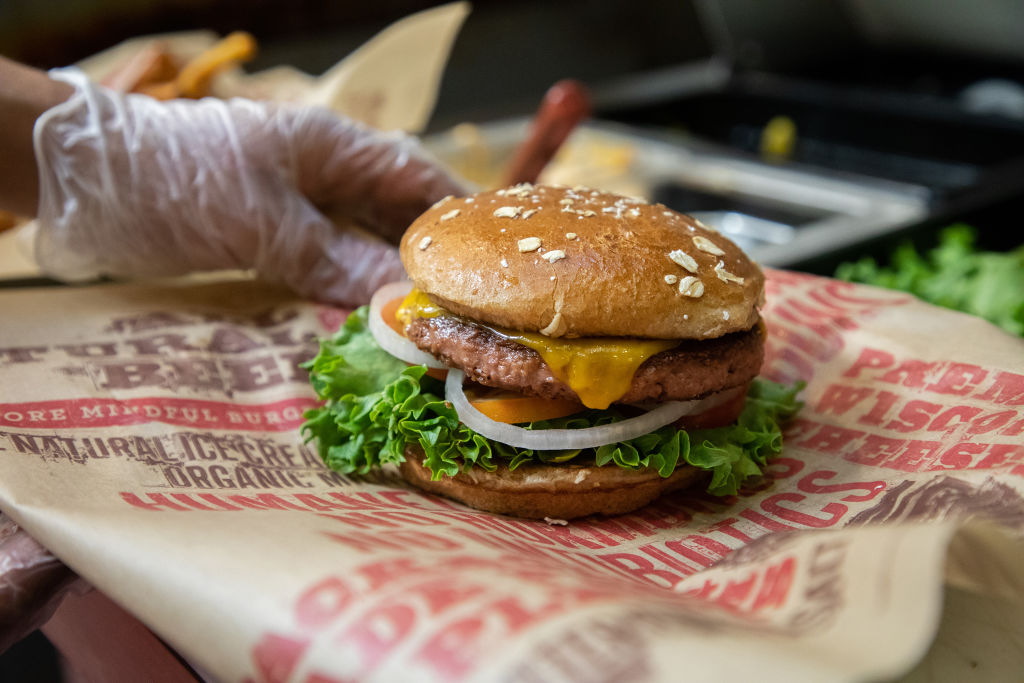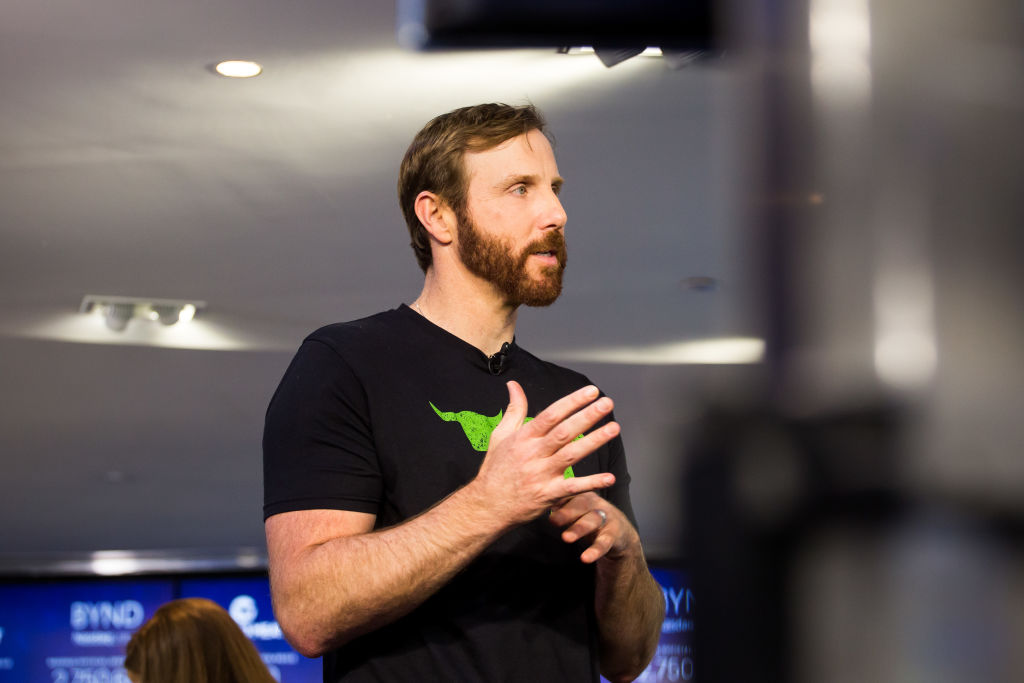In retrospect, rising as high as Ethan Brown did four years ago might almost guarantee a brutal, Greek tragedy-style fall from grace somewhere down the line. Back in 2019, the CEO and founder of faux-hamburger startup Beyond Meat closed the most successful IPO since the financial crisis. Partnerships with McDonald’s and KFC were in the works, and the investor presentations were all upside, with plant-based hamburgers poised to take an enormous bite out of a $270 billion meat industry. It was all for a good cause, too. In talks and interviews with friendly journalists (including two sit downs with this magazine) Brown spoke about how his products could help change the world by cutting livestock emissions, improving people’s health, and displacing the systematic animal cruelty that underpins Americans’ eating habits. It was a rare business that was doing well while doing good—and it helped that it was doing really, really well.
Today, Brown still has the same talking points—environment, health, animal welfare—but fewer people seem to be listening. Instead, there’s only one question on the minds of financial analysts and business journalists: Can Beyond Meat actually make money? Brown has had plenty of time to think about the dynamic. “When you’re doing well, they make you seem like you have the Midas touch,” he says, speaking in a hotel room in Midtown Manhattan last week. “When you’re struggling, it’s the opposite. You just have to be comfortable with both.”
It’s rougher out there than it was during the plant meat glory days. High food prices have caused shoppers to forgo expensive meat alternatives, while cooling hype and high interest rates have tightened the spigot of venture capital that fuels the industry’s smaller players. More than a dozen startups in the space have folded in recent months. Beyond Meat, the O.G. that started it all, has fared particularly badly in some ways, especially compared to its biggest rival, Redwood City, Calif.-based Impossible Foods (it helps though, that Impossible is a private company, which means it can keep its financials close to the chest). From a supernova IPO peak of $234 per share in 2019, Beyond’s stock price is down to just $15.81 as of July 20. The company posted a loss of $366 million last year—though that wouldn’t be so bad if burning that cash had pushed Beyond products onto more menus and dinner plates. Instead, global sales numbers fell almost 10%. In October, the company laid off 19% of its staff, and it’s also seen three high-profile C-suite departures.
More from TIME
Brown has been trying to turn things around. In May the company released new quarterly financials that seemed to show some modest progress. Beyond had slowed its cash burn to $59 million from more than $100 million during the same quarter in 2022, beating analysts expectations. But there was also more bad news this spring: an investor lawsuit claiming that Brown and fellow executives had lied about the company’s business prospects back in the good old days in order to inflate the company’s stock price. (The company plans to contest the claims, which is says lack merit.)
Brown has often given reporters the silent treatment when they come knocking to talk about Beyond’s struggles. A January cover story from Bloomberg Businessweek, for instance, had nary a peep from Beyond’s CEO. Speaking last week, though, Brown says that there’s nothing so unusual about Beyond’s position. In some ways, he says, it’s a sign of its success. “Have we seen a disruptive company that’s truly challenging something as big as we’re challenging, that hasn’t gone through this?” Brown says. “You go through euphoria, where people are loving you. You go into the trough of disillusionment. And then you come back.”

Behind me, Beyond Meat’s executive chef Diana Stavaridis, a.k.a. Chef D, is whipping up sample portions of the company’s products, and the smell and sizzle of not-meat permeates the room. What she’s cooking is the reason Brown and I are here. For years, the company has been working on what might be considered the Holy Grail of fake meat imitations, a full filet steak, and they’ve invited TIME for a first taste.
Chef D sets down three slices of it in front of me, accompanied by a dab of mashed potatoes and a tiny pool of steak sauce. It looks exactly like steak. It tastes pretty good, too. Maybe not like a steak steak, but a reasonable facsimile to be sure. It had some of the consistency of a piece of meat, though it put up a bit less resistance to the fork. It gets an A+ for a nifty caramelized crust. Brown couldn’t help but break the illusion, though. “The form is super interesting. It can be any form,” he says as I take a third bite. “I can spell your name with it.”
It’s hard not to be impressed. The imitation is a lot more convincing than other steak alternatives I’ve tried. Whereas past months have seen Brown on the defensive, the arrival of this steak is reminiscent of the bold Beyond Meat founder of yesteryear—that messianic enviro-capitalist who put veggie burgers in the meat section, who wanted meat-eaters to choose his patties, and put the world’s top food scientists to work to make it happen. The old Beyond Meat, perhaps, is back.
Read more: We Tasted The World’s First Cultivated Steak, No Cows Required
Brown is cagey about how this new “meat” is constructed. It’s got fava beans in it, and mycelium—the thin root-like tendrils that mushrooms and other fungi form as they grow, and which binds together soybeans in tempeh, a vegetarian staple. But the method by which Brown and his company contort those elements into their “steak” is strictly under wraps. So is the projected price for consumers. It’s not launching in the near-term either—all Brown would promise was that it would hit shelves sometime next year. The formula also might change between now and then—what I tried, he says, was a prototype.
Instead, the company’s latest and greatest imminent offering is… another Beyond Burger. Called the Stack Burger, it’s thinner, and it’ll exclusively be sold in the frozen section starting later this summer. Pricing info isn’t available, but a company representative says they’ll be cheaper per patty than the original burgers, since they’re smaller. The company also says it improved the taste—though I had trouble telling the difference in the one Chef D set down in front of me. The idea, Brown’s publicist Shira Zackai says, is to make something that competes with the trend of thinner, smaller smash burgers. What I saw was more so Beyond’s answer to the ubiquitous cardboard-packaged Bubba Burger: those cheap, thin, greasy patties that dads grill up in the dozens for block parties, which cook fast and go down easy with ketchup, and that you wouldn’t dream of ordering any way other than well done.
Those frozen hamburgers, not the steaks, are perhaps more representative of Beyond Meat’s strategy right now. There won’t be any headlong charges for growth, Brown says. Instead, the company is focusing on profitability and preparing for a battle of attrition, hunkering down and conserving resources until it dawns on people that eating meat is destroying their bodies, and the planet. “If we can keep our cash burn to a minimum, we’ve got tremendous runway,” Brown says. The company will need that cash to keep going in what’s become a knock-down drag-out fight with Big Meat for market share. “The idea here is to set the record straight around health, continue to improve our products, get through to the mainstream,” Brown says. “That’s our entire focus.”

Health concerns, in addition to the price of its products (Beyond Burgers are still usually more expensive than ground beef in the grocery store, despite recent price cuts) are probably the biggest impediment that Beyond Meat is facing right now. The incumbent meat industry has used this as a cudgel against the startup. Groups allied with meat producers have launched a stream of attack ads in recent years, claiming that meat substitutes are unhealthy due to their complicated processing and long ingredient lists. Brown says those criticisms are unfounded—the extrusion process that turns pea protein into something that resembles meat is akin to using a pasta-maker, he insists. Yet he also says that the company has focused on simplifying ingredient lists for its new steak tips product, launched last fall. This includes nixing the common food additive methylcellulose that serves as a binding agent and has been the target of criticism over perceived health concerns (the U.S. Food and Drug Administration has long recognized methylcellulose as a safe food additive). The company has also funded health studies and started working with medical nonprofits like the American Heart Association. That group certified Beyond’s steak tips as being heart healthy in May. The new stack burger, though, has a similar ingredients list to currently available Beyond Burgers, according to Beyond Meat representatives, including methylcellulose.
Read more: The Cow That Could Feed the Planet
The currently available Beyond Burgers contain 25% of the recommended daily serving of saturated fat, based on a 2,000 calorie diet (the steak has a lot less). But Brown insists the health comparisons should be made against the potentially carcinogenic, cholesterol-laden red meat that’s slowly killing Americans. “The way to think about plant-based meat in general is not that it is something that will win on a health comparison against a kale salad,” he says. “You should think of plant-based meat as like that Dos Equis ad … when you eat meat, it should be plant-based meat.”
Later, though, after I try the steak, he reverts to sell mode. “You could have it every night,” he says.
The actual science on Beyond Meat’s purported health benefits is fuzzy, especially due to the competing interests funding much of the research. A study conducted by researchers at Stanford University and funded by Beyond Meat showed improvements to cardiovascular risk factors from eating its products compared to eating meat. A study by Duke University researchers and partially funded by the North Dakota Beef Association compared the chemical profiles of plant-based meat and grass-fed ground beef. It was inconclusive as to which was healthier to eat.

My own bias is that I like what Beyond Meat is doing, in principle—though its burgers and steak bits are too pricey. The global meat industry is responsible for 14% of the world’s emissions, but exhortations to eat more vegetables and beans aren’t getting people to eat any fewer animals. If Brown’s products can make a dent, I’m all for them. And I agree with at least one of his longtime points: business as usual in industrial meat production is not an option. Either it goes, or we do.
Towards the end of my time with Brown, I asked him about his gilded era—if maybe he wishes he had done more to temper expectations, considering the hard road that was before him. His response is to point out that there’s an inevitably here—that we have to change what we eat. Perhaps, though, the exact timeline wasn’t so clear. “Whether you get there in year three or year 10, we can’t predict that,” he says.
Then he points out the success that Beyond products have had in fast food chains in Europe. McDonald’s pulled Beyond patties from its U.S. locations last year, for instance, but they’re going strong in Germany, the U.K., Austria, and the Netherlands. The difference may have to do with Beyond Meat getting wrapped up in the U.S. culture war, with conservatives pledging that environmentalists will pry their high emission pork links and hamburgers out of their cold dead hands. Abroad, though, those forces are less intense, and the meat industry is not so formidable.
Brown, for his part, is all conviction. “The fact that it’s not happening here doesn’t mean that it’s not happening. It’s just not happening where people are looking,” Brown says. “This will happen here, mark my words. It’s just a question of time.”
Update, July 20: This story has been updated to include a comment from Beyond Meat on the May 2023 investor lawsuit, and to more specifically state the saturated fat content of a Beyond Burger.
More Must-Reads from TIME
- Cybersecurity Experts Are Sounding the Alarm on DOGE
- Meet the 2025 Women of the Year
- The Harsh Truth About Disability Inclusion
- Why Do More Young Adults Have Cancer?
- Colman Domingo Leads With Radical Love
- How to Get Better at Doing Things Alone
- Michelle Zauner Stares Down the Darkness
Write to Alejandro de la Garza at alejandro.delagarza@time.com
